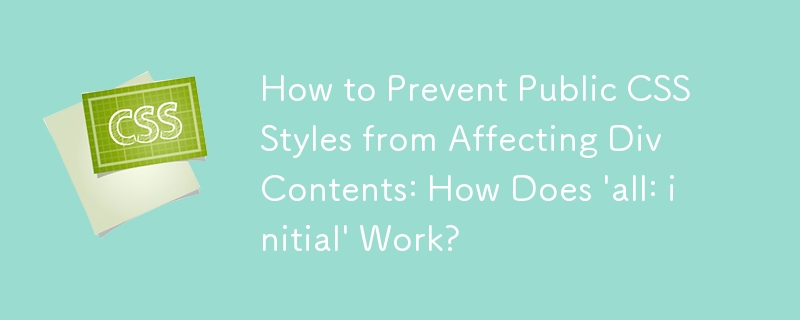 Web Front-end
Web Front-end
 CSS Tutorial
CSS Tutorial
 How to Prevent Public CSS Styles from Affecting Div Contents: How Does \'all: initial\' Work?
How to Prevent Public CSS Styles from Affecting Div Contents: How Does \'all: initial\' Work?
How to Prevent Public CSS Styles from Affecting Div Contents: How Does \'all: initial\' Work?

How to Prevent Public CSS Styles from Affecting Div Contents
In HTML code, div tags are commonly used to group elements for styling purposes. However, it is sometimes necessary to isolate the content within a div tag from the styling applied to the public CSS stylesheet.
CSS Inheritance and Cascading
CSS styles are inherited by child elements from their parent elements. This means that if an image and a heading tag are both inside a div tag, they will inherit the CSS properties applied to the div tag, except in specific cases.
Blocking Inheritance with 'all: initial'
To prevent the content within a div tag from being affected by public CSS styles, you can use the CSS property 'all: initial'. This property resets all inherited and defined CSS properties to their initial values.
Code Example
To isolate the div content in the given HTML code, the following CSS can be used:
<code class="css">#mydiv {
all: initial; /* resets inheritance for all properties */
}</code>Allowing Inheritance Within Div Tag
While 'all: initial' blocks inheritance, it's possible to allow it within the div tag itself. To do this, you can use the 'all: unset' property on the descendant elements of the div tag:
<code class="css">#mydiv * {
all: unset; /* allows inheritance within #mydiv */
}</code>Browser Support
The 'all' shorthand property is widely supported in modern browsers, including Chrome, Firefox, Safari, and Edge. For broader support, you can use the longer version, which involves setting every CSS property to its initial value:
<code class="css">#mydiv {
/* ... (set all CSS properties to 'initial') ... */
}</code>Conclusion
By using 'all: initial' to block inheritance and 'all: unset' to allow it within the div, it is possible to isolate the content of a div tag from the public CSS stylesheet. This technique is particularly useful for creating self-contained widgets or components.
The above is the detailed content of How to Prevent Public CSS Styles from Affecting Div Contents: How Does \'all: initial\' Work?. For more information, please follow other related articles on the PHP Chinese website!

Hot AI Tools

Undresser.AI Undress
AI-powered app for creating realistic nude photos

AI Clothes Remover
Online AI tool for removing clothes from photos.

Undress AI Tool
Undress images for free

Clothoff.io
AI clothes remover

Video Face Swap
Swap faces in any video effortlessly with our completely free AI face swap tool!

Hot Article

Hot Tools

Notepad++7.3.1
Easy-to-use and free code editor

SublimeText3 Chinese version
Chinese version, very easy to use

Zend Studio 13.0.1
Powerful PHP integrated development environment

Dreamweaver CS6
Visual web development tools

SublimeText3 Mac version
God-level code editing software (SublimeText3)

Hot Topics
 1664
1664
 14
14
 1422
1422
 52
52
 1316
1316
 25
25
 1268
1268
 29
29
 1240
1240
 24
24
 Google Fonts Variable Fonts
Apr 09, 2025 am 10:42 AM
Google Fonts Variable Fonts
Apr 09, 2025 am 10:42 AM
I see Google Fonts rolled out a new design (Tweet). Compared to the last big redesign, this feels much more iterative. I can barely tell the difference
 How to Create an Animated Countdown Timer With HTML, CSS and JavaScript
Apr 11, 2025 am 11:29 AM
How to Create an Animated Countdown Timer With HTML, CSS and JavaScript
Apr 11, 2025 am 11:29 AM
Have you ever needed a countdown timer on a project? For something like that, it might be natural to reach for a plugin, but it’s actually a lot more
 HTML Data Attributes Guide
Apr 11, 2025 am 11:50 AM
HTML Data Attributes Guide
Apr 11, 2025 am 11:50 AM
Everything you ever wanted to know about data attributes in HTML, CSS, and JavaScript.
 A Proof of Concept for Making Sass Faster
Apr 16, 2025 am 10:38 AM
A Proof of Concept for Making Sass Faster
Apr 16, 2025 am 10:38 AM
At the start of a new project, Sass compilation happens in the blink of an eye. This feels great, especially when it’s paired with Browsersync, which reloads
 How We Created a Static Site That Generates Tartan Patterns in SVG
Apr 09, 2025 am 11:29 AM
How We Created a Static Site That Generates Tartan Patterns in SVG
Apr 09, 2025 am 11:29 AM
Tartan is a patterned cloth that’s typically associated with Scotland, particularly their fashionable kilts. On tartanify.com, we gathered over 5,000 tartan
 How to Build Vue Components in a WordPress Theme
Apr 11, 2025 am 11:03 AM
How to Build Vue Components in a WordPress Theme
Apr 11, 2025 am 11:03 AM
The inline-template directive allows us to build rich Vue components as a progressive enhancement over existing WordPress markup.
 While You Weren't Looking, CSS Gradients Got Better
Apr 11, 2025 am 09:16 AM
While You Weren't Looking, CSS Gradients Got Better
Apr 11, 2025 am 09:16 AM
One thing that caught my eye on the list of features for Lea Verou's conic-gradient() polyfill was the last item:
 A Comparison of Static Form Providers
Apr 16, 2025 am 11:20 AM
A Comparison of Static Form Providers
Apr 16, 2025 am 11:20 AM
Let’s attempt to coin a term here: "Static Form Provider." You bring your HTML



